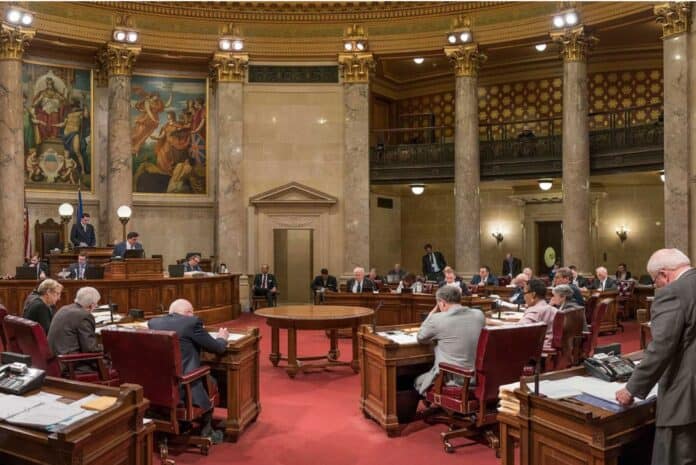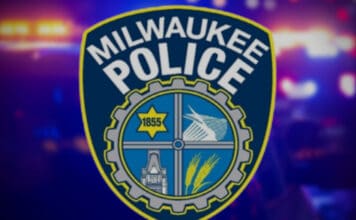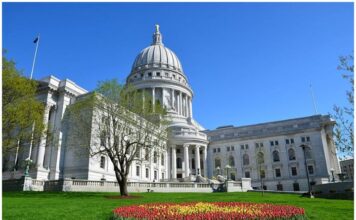By: Ed Brey
So a guy walks into a bar. Something funny’s coming, right? Now let’s change it up a bit. A guy walks into the girls’ locker room. He’s a senior and there are four freshman girls showering. He allegedly completely undresses right in front of them. Sorry, but there’s no punch line for that one.
Nor does the line, “I’m trans, by the way,” make the incident OK. How was it even a question as to whether he was permitted into the locker room to begin with? Well, according to the Sun Prairie East High School Restroom and Locker Room Accessibility Guidance, you have to take such situations on a “case-by-case basis”.
Such an outcome from wishy-washy school rules should surprise no one. Yet for many districts, even districts in conservative-leaning communities, instead of having clarity, it’s laissez-faire and cross your fingers. To their credit, administrations, and staff often work informally to prevent problems, but such efforts are only able to go so far.
School boards and administrators never used to take these kinds of chances with their girls. What’s changed? What’s behind the lax standards? And what can Wisconsin lawmakers do about it?
What’s changed is the arrival of a new class of lawsuits. Mounting a defense against a well-funded firm representing a transgender student is hardly central to a school’s mission of educating students through the prudent use of taxpayer funds. Districts have a strong incentive to stay squarely within the law, but that gets tricky when the law is an evolving jumble of often contradictory court cases and departmental memos. Such is the case with transgenderism.
To handle the complexity amid a thousand other tasks, school administrators often turn to training and guidance from the Wisconsin Association of School Boards to boil down the issues. The problem is that the guidance is too simple. It generalizes cases beyond the courts’ rulings, leaving administrators mistakenly believing they are legally bound to sacrifice girls’ safety and rights.
For example, ask your principal or superintendent if a boy is allowed in the girls’ restroom. Does the answer sound something like the recommendation cited in WASB’s August 2020 LGBTQ sidebar of common legal questions that a school “accommodate a student’s request to utilize the restroom that aligns with the student’s personally identified gender”?
WASB’s guidance comes after analyzing Whitaker, the controlling case for our part of the country, and cases in other regions. Each case wasn’t about just “a student.” Specific facts matter. I’m not a lawyer, but plenty of people at the Wisconsin Institute of Law and Liberty are and provided a memo that fills in important details:
To give just one example, the Seventh Circuit itself pointed out that Whitaker was “not a case where a student has merely announced that he is a different gender” but rather one where the plaintiff had “a medically diagnosed and documented condition.” Moreover, the Court concluded that “since his diagnosis, he has consistently lived in accordance with his gender identity” and his decision to do so “was not without cost or pain.” Id. at 1050. Thus, even Whitaker seemed to acknowledge that a school district does not automatically need to allow any student that asserts a transgender identity to use the opposite-sex bathroom but may require some sort of verification. This is only one example of the ways in which Whitaker might be distinguished in a future case on this topic.
WASB’s August 2020 guidance makes no mention of the distinguishing features, nor does its March 2021 guidance. Further, WASB has no guidance incorporating subsequent court opinions that directly contradicts Whitaker. That’s important because WASB’s generalizations seem largely based on the outdated premise that “prior efforts to prevent transgender students from using bathroom facilities consistent with their gender identities have been uniformly rejected by the courts.”
There’s a big difference in student safety between a single student known to school staff to have a diagnosed medical condition versus any male deciding one day to walk into a girls’ shared private space at an opportune time. Sound guidance will help schools be specific in their procedures.
The problem extends beyond shared private spaces. Say a girl turns to gender transitioning as a “fresh start” and a possible way out of her teen troubles. She wants a new name—a boy name—at school but doesn’t want her parents to know. Ask your principal if your school would hide the situation from her parents.
You might be surprised to hear that because schools don’t notify about Rebecca going as Becky, it can be considered discriminatory to notify if Sally starts going by Harry. What you likely won’t hear is an analysis of the gender identity discrimination involved in notifying Sue’s request to be called Glum because she started experiencing one medical condition, depression while hiding Sally’s name change to Harry caused by a different medical condition, gender dysphoria.
Thorough guidance would put schools in a position to partner most closely with the parents responsible for their students. Sally’s parents know her better than anyone and are best equipped to get her the help she needs with any underlying problems.
Schools do need to be wary of legal risks, but it can be easy to put too much focus on the risk of transgender students seeking special accommodations. The wake-up call in Sun Prairie reminds us that the larger risk is what happens if schools dismantle our longstanding safeguards. And it’s not just schools’ legal risk of neglecting their students’ safety, it’s the risk to the students themselves.
Wisconsin Legislative Council
Fortunately, the Wisconsin legislature is in an excellent position to give schools the help they need, even without help from the executive branch. The Wisconsin Legislative Council regularly issues memos that provide guidance on a host of issues. In November 2011, it issued the memo Title IX: Federal Protection Against Sex Discrimination in Education. The legislature can use the Legislative Council as a platform from a democratically elected body to provide schools with up-to-date guidance on case law compliance with the factual detail needed to best preserve both legality and student safety.
The legislative counsel guidance should be practical for schools and accessible for parents. A parent should be able to ask a principal if the school is following the Legislative Council guidance, and if not, why not.
Student Safety Laws
The Wisconsin legislature should also pass laws requiring schools to meet minimal safety standards for shared private spaces and for parental notification. While local control should always remain an important tenet of Wisconsin school laws, improved safety standards would follow a sound tradition, such as keeping photography out of locker rooms and mandatory reporting.
The threat of a governor veto should not dissuade legislators from doing what they believe best serves Wisconsin students. Let the governor and individual members of the legislature be on the record for their stances on allowing boys in girls’ locker rooms or hiding information from parents.
If a bill is passed, it shifts the risk of a legal challenge from some individual school to the State of Wisconsin. The state is in a better position to take any challenge that may come, leaving school districts free to focus on academic excellence and keeping students safe.
Ed Brey is a member of the Sheboygan Falls School Board writing in his individual capacity.
Table of Contents
































